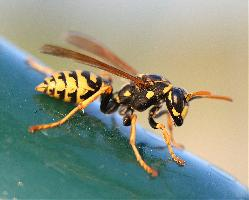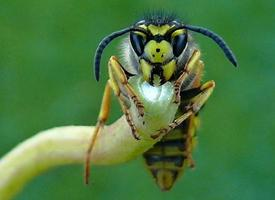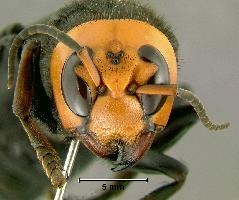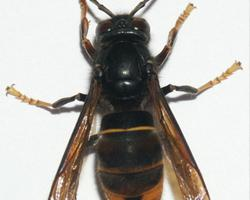
Váhy a míry
| Délka | od 18 do 30 mm |
|---|
Stav ohrožení
| Neohrožen |
Popis zvířete
The Asian hornet, scientifically known as Vespa velutina, is an invasive species of hornet that is native to Southeast Asia. This species has garnered significant attention due to its expansion into new territories, notably Europe, where it poses a threat to local ecosystems and economies, particularly the beekeeping industry. The Asian hornet is distinguishable by its striking appearance and behavior, which have made it a subject of both fascination and concern.Physical Description:
The Asian hornet is a visually striking insect, characterized by its sizeable body that can measure up to 3 centimeters in length for queens, with workers being slightly smaller. It has a distinctive coloration that sets it apart from other hornet species; the body is predominantly black, with the fourth segment of its abdomen being yellow or orange, providing a stark contrast against the darker segments. The legs of the Asian hornet are brown with yellow tips, and its face is orange with two deep-set, dark eyes. The wings of the hornet, which extend beyond its body when at rest, have a smoky, dark tint, adding to its intimidating appearance.
Habitat and Distribution:
Originally from Southeast Asia, the Asian hornet has been steadily expanding its range. It was first reported in France in 2004, believed to have been accidentally introduced through human activities, and has since spread to various other European countries. The hornet thrives in both rural and urban settings, often building large, pear-shaped nests in tall trees, but also in shrubs, on buildings, or other structures. These nests are constructed from chewed plant material, giving them a distinctive papery appearance.
Diet and Behavior:
The Asian hornet is a voracious predator, feeding primarily on insects, including bees, wasps, and other pollinators. It is particularly notorious for its impact on honeybee populations. Groups of hornets will hover in front of a beehive, picking off returning foragers and eventually leading to the collapse of the hive if not managed. This behavior not only threatens local bee populations but also poses a significant challenge to beekeepers and can impact pollination services in affected areas.
Impact and Management:
The introduction and spread of the Asian hornet in non-native areas have raised ecological and economic concerns. Efforts to manage and control its population include monitoring and destroying nests, using bait traps, and educating the public and beekeepers on detection and protection measures. Research into biological control methods and the hornet's behavior is ongoing to find more effective strategies to mitigate its impact.
Conservation Status:
While the Asian hornet is considered invasive and a pest in its introduced ranges, in its native habitat, it is a natural part of the ecosystem. Its conservation status in its native range has not been a major concern; however, the focus remains on its management in areas where it poses a threat to biodiversity and human activities.
In conclusion, the Asian hornet (Vespa velutina) is an invasive species that has attracted significant attention due to its predatory behavior, particularly towards honeybees, and its rapid spread across Europe. Its distinctive appearance, ecological impact, and the challenges it presents for management underscore the importance of international cooperation and research in controlling its population and mitigating its effects on local ecosystems and economies.
Mapa výskytu
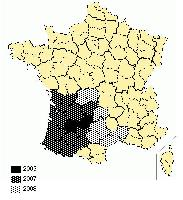
Podobná zvířata
Nové fotografie zvířat
Top 10 zvířat
- Chinese water dragon (Physignathus cocincinus)
- Galápagos tortoise (Geochelone nigra complex)
- Dolphin gull (Leucophaeus scoresbii)
- Japanese macaque (Macaca fuscata)
- Colombian red howler (Alouatta seniculus)
- Sea urchins (Echinoidea)
- Diana monkey (Cercopithecus diana)
- Moustached guenon (Cercopithecus cephus)
- Colossal squid (Mesonychoteuthis hamiltoni)
- Common house mosquito (Culex pipiens)
